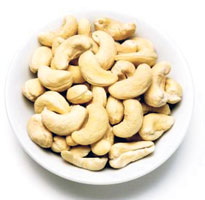The Cashew tree is a native of the coastal areas of Brazil. In the 16th century, Portuguese explorers took these trees from this South American country and introduced them to other tropical regions and some African and Asian countries such as India and Sri Lanka where they are now cultivated.
The cashew tree has always been a prized resource owing to its precious wood, cashew balm and cashew apple (fruit); but the cashew nut itself did not gain popularity until the beginning of the 20th century. Today, the leading commercial producers of cashew are India, Brazil, Mozambique, Tanzania and Nigeria.
Cashews known scientifically as Anacardium occidentale belong to the same family as the mango and pistachio nut.
How to select and store
Cashew is generally available in prepackaged containers. When you purchase cashew in a packaged container, make sure there is no evidence of moisture or insect damage and that the nuts are not shrivelled. If it is possible to smell the cashews, do so to ensure that they are not rancid.
Due to high content of oleic acid (which is a mono-unsaturated fatty acid), cashew is more stable than most other nuts, but should still be stored, in a tightly sealed container in a refrigerator where they will keep for about six months or in a freezer where they will keep for about one year.
About the nut
Cashew nuts are actually the kidney-shaped seeds that adhere to the bottom of the cashew apple, the fruit of the cashew tree. While cashew apples are not appreciated by most urban Sri Lankans, they are recorded as delicacies in Brazil and the Carribean.
In Sri Lanka, cashew are almost always sold after removing the shells. You have probably noticed that cashews in shells are not available in our boutiques, Sunday fairs and supermarkets. To roast cashews at home do so gently in a 160-170 degree F oven for 15-20 minutes to preserve the healthy oils.
Nutritional and
medicinal value
Cashew is nature’s vitamin pill. Cashew kernel of 100 gms contributes about 600 calories. It has a balanced nutritive profile. The nutritive values present in cashew kernels are protein, fats, carbohydrates, vitamins and minerals. It is a source of minerals like calcium, magnesium, phosphorus, sodium, iron and other minerals which help to prevent anaemia and nervous ailments.
Cholesterol
Cashews are rich in fat. The fat constitutes about 47% of the total weight of the nut. This could be good news for people who feel weak or debilitated, but what does it mean to people who are conscious of their weight and fat intake?
Cashew has 0% cholesterol. Cashews have what is called the "good" fat. I do admit that cashews will add to your weight if you consume cashew ad lib, but moderate consumption is beneficial.
The ratio of saturated:mono unsaturated:polyunsaturated is 1:2:1. This is the ideal for human consumption. The relative abundance of mono-unsaturated fatty acids in the cashew nut is an advantage for heart patients with low good (HDL) cholesterol. The fatty acid profile of fatty acids in cashew is conducive to the promotion of good health and the relative abundance of fat in the cashew nut does not pose a nutritive risk.
Nutritive values for 100gms of Cashew
Water 1.4%
Protein 20.5%
Fat 50%
Carbohydrate 18.7%
Energy 611kcal
Fatty acid for 100g of Cashew nuts
Saturated fatty acids 10%
Mono unsaturated fatty acids 29.4%
Polyunsaturated fatty acids 9.1%
Inorganic composition for
100g of Cashew
Sodium 290mg
Potassium 730mg
Magnesium 250mg
Phosphorous 510mg
Iron 6.2mg
Copper 2.04mg
Zinc 2.04mg
Chloride 490mg
Manganese 1.8mg
Selenium 34 mg
Vitamin content
Retinol 6.0 (i.u.)
Carotene 6.0
Vitamin E 1.30
Thiamine 0.41
Riboflavin 0.16
Niacin 1.30
Foliate 68.0
Pantothenate 1.08
Biotin 13.0
Essential Amino Acids
Argine 650
Histiodine 130
Lysine 290
Tryptophan 110
Phenylalamine 270
Methionine 90
Threonine 200
Leucine 510
Health benefits
Heart-protective mono-
unsaturated fats
Not only do cashew nuts have a lower fat content than most other nuts, approximately 75% of this is unsaturated fatty acids plus about 75% of this unsaturated fatty acid content is oleic acid, the same heart healthy mono unsaturated fat found in olive oil. Studies show that oleic acid promotes good cardiovascular health even in individuals with diabetes.
Studies of diabetic patients show that mono-unsaturated fat when added to low fat diet can help to reduce high triglyceride levels. Triglycerides are a form in which fats are carried in the blood and high triglyceride levels are associated with an increased risk of heart disease, so ensuring you have some mono unsaturated fats in your diet by enjoying cashew is a healthy option for persons with diabetes. Just a quarter cup of these delicious nuts supplies 37.4% of the daily value of mono unsaturated fat. In addition, it is a good source of copper magnesium, zinc and biotin.
Copper for antioxidant defences, energy production, bones and blood vessels
An essential component of many enzymes, copper plays a role in a wide range of physiological processes including iron utilization, elimination of free radicals, development of bone and connective tissue and development of the skin and hair pigment, melanin.
Copper is an essential component of enzyme super oxide dismutase which is important in energy production and antioxidant defences. Low dietary intake of copper may also be associated with increased free radical production and faecal water alkaline phosphatase activity, a risk factor for colon cancer.
Numerous health problems such as iron deficiency anaemia, ruptured blood vessels, osteoporosis, joint problems such as rheumatoid arthritis, brain disturbances, elevated LDL (bad) cholesterol level, irregular heart beat and increased susceptibility to infections can develop when your copper intake is inadequate.
Topping your morning cereal with a quarter cup of cashew will supply you with 38.0% of the daily recommended value of copper. |

